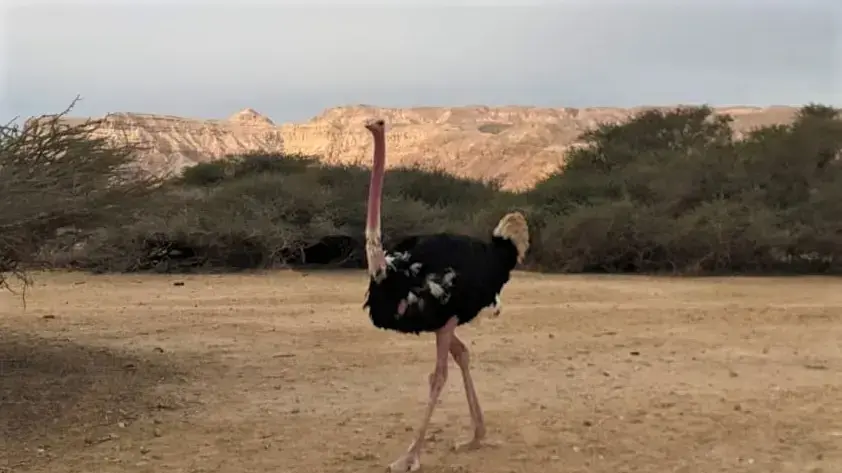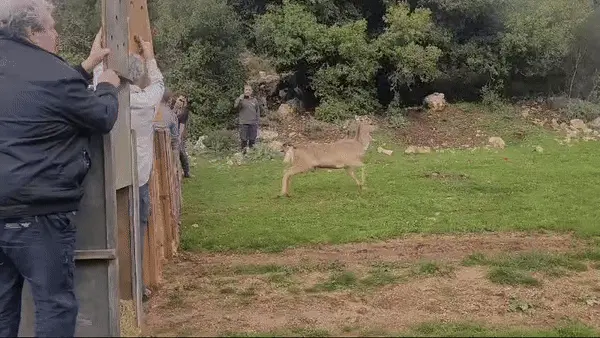"Franco" a red-necked ostrich was released into the Yotbata wild (photo: Israel Nature and Parks Authority)
"Franco" is a young red-necked ostrich about six months old, the only one that successfully survived out of four ostrich eggs that hatched this year in the Yotbata Wildlife Reserve, managed by the Nature and Parks Authority.
Almost every day, inspectors and caretakers of the Yutbata Wildlife Reserve meet him in the areas of the reserve and are excited to see his independent integration with the other ostriches and other wild animals that roam the reserve.
His story is particularly exciting since his hatching was in an artificial hatchery in wild animals, which gives hope to the joint recovery efforts of the species that the Nature and Parks Authority is promoting together with the corresponding agencies in the country of Senegal, after the species there was almost extinct in the wild.
Franco grew up in a hatchery in Israel, after he almost became extinct in Senegal (photo: Nature and Parks Authority)
And here he is already frolicking like a little boy (Photo: Nature and Parks Authority)
An artificial hatchery for ostrich eggs was established in the wild animal reserve
The joint project with Senegal began in recent years under the leadership of Roni Malka, a retiree of the Nature and Parks Authority and former director of the Authority's enforcement division.
This is after DNA tests revealed that the ostriches in the Yutbata Wildlife Reserve (red-necked ostrich/North African ostrich) are almost identical to the subspecies that lives in Senegal. With the launch of the international cooperation to save the species, an artificial hatchery for the ostrich eggs was established in the wildlife reserve, with the aim To establish a significant local breeding nucleus and support Senegal to establish one of its own, based on ostrich eggs from Israel. This is, among other things, so that Senegal will also return them to the wild in suitable reserves on its territory and thereby recover their population, which is in danger of extinction. In
the wild, about 30 red-necked ostriches will benefit and their survival And the fertility of ostrich eggs in the open is not high at all. Therefore, a number of eggs that have been transferred so far from Israel to Senegal in a controlled manner have not hatched successfully in most cases. Meanwhile, the challenge is how eggs incubated in an artificial hatchery can integrate into nature.
However, the story of Franco who hatched in the hatchery gives hope for recovery efforts.
Franco hatched in June 2022 after 40 days in the hatchery.
He was raised under the strict supervision of the caretakers of the wild animal until he was six months old in a protected area in the reserve to protect him from predators until he grew and got stronger.
At the end of the year, after he had grown a bit, he was moved to the more open area in the Yotbata Wildlife Reserve where he first met his own kind and the other wild animals living in the reserve.
Franco returns to the desert where he will live, in the southern Araba (photo: Israel Nature and Parks Authority)
It is not known if Franco is male or female
In the first few days, he seemed to have difficulty adjusting and did not receive a particularly warm welcome from the other wild animals.
The wildlife team followed him closely, making sure he was managing the food successfully and even reinforced him with food from the side in a supervised manner.
About a week later he seems to have found his place and is finding his food on his own, and is doing well.
By the way, it should be noted that it is not yet known whether Franco is male or female since he has not yet been tested for sex.
In a few months, based on his feathers it will be possible to discover his gender.
If he has black feathers with white touches, it will be possible to determine that his species is male.
If gray feathers adorn him, the crew will probably have to get used to the fact that Franco is actually a female.
In any case, its integration now in the open field can already probably testify to the possibilities of success of the return to nature both in Israel and in Senegal, from eggs raised in an artificial hatchery.
In the hope that the species will not become extinct in Senegal and in the world in general.
tourism
news
Tags
ostrich












